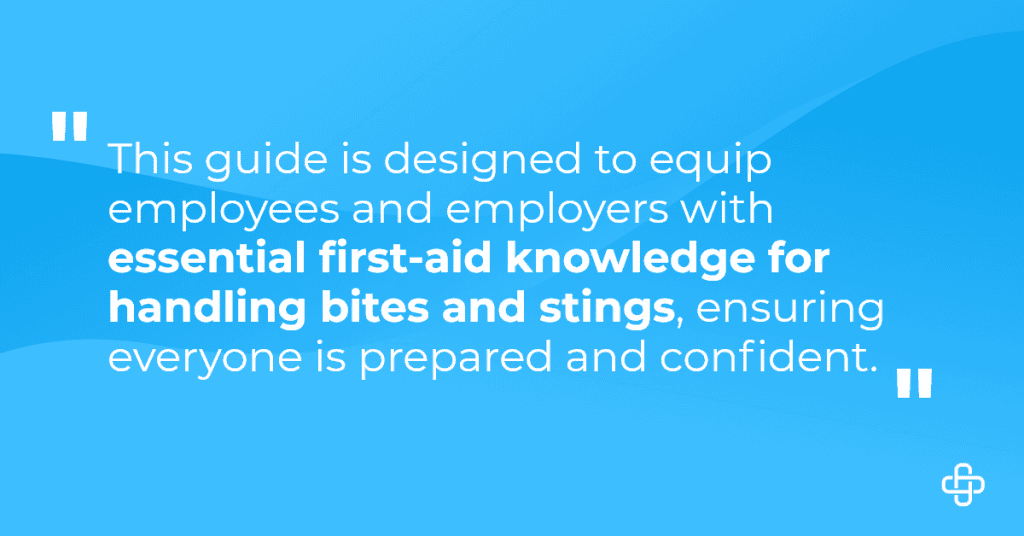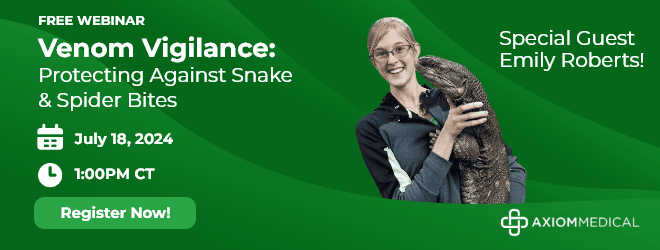The workplace can be unpredictable. While we often focus on machinery safety and ergonomics, bites, and stings from insects and animals are frequently overlooked risks.
These can range from mildly annoying to potentially life-threatening. Knowing how to respond promptly and effectively can significantly impact the outcome.

This guide is designed to equip employees and employers with essential first-aid knowledge for handling bites and stings, ensuring everyone is prepared and confident.
Common Bites and Stings Identifying the Culprits
Understanding what you might encounter is the first step in preparedness. Here are some common offenders:
Insects
- Bees and Wasps: Bees leave their stingers behind, releasing venom that causes pain, swelling, and sometimes severe allergic reactions. Wasps, on the other hand, can sting multiple times.
- Mosquitoes: These pests are more than just a nuisance. They can transmit diseases like West Nile Virus, Zika, and Malaria.
- Ticks: Often found in grassy or wooded areas, ticks can carry Lyme disease and other serious illnesses.
Animals
- Dogs and Cats: Animal bites can cause puncture wounds, potentially leading to infections if not treated promptly.
- Snakes: Venomous snakes like rattlesnakes or copperheads can inject toxins that require immediate medical attention.
- Rodents: Bites from rats or mice can transmit diseases like hantavirus or leptospirosis.
Immediate Steps: What to Do at the Scene
Time is of the essence when dealing with bites and stings. Here’s what you need to do right away:
For Insect Stings
- Stay Calm: Panic can exacerbate symptoms. Take a deep breath and remain composed.
- Remove the Stinger: If you are stung by a bee, scrape the stinger out with a credit card or similar object. Avoid using tweezers, as they can squeeze more venom into the wound.
- Clean the Area: Wash the site with soap and water to prevent infection.
For Animal Bites
- Ensure Safety: Move away from the animal to prevent further attacks.
- Stop the Bleeding: Apply gentle pressure with a clean cloth or bandage to stop the bleeding.
- Clean the Wound: Rinse the wound thoroughly with water and apply antiseptic.
For Snake Bites
- Get to Safety: Move the victim away from the snake’s reach.
- Immobilize the Affected Limb: Keep the limb still, and at heart level to slow the spread of venom.
- Seek Immediate Medical Help: Call emergency services or get to the nearest hospital.
First Aid Protocols Step-by-Step Guide
Every scenario demands a specific approach. Follow these detailed protocols to provide effective first aid.
For Bee and Wasp Stings
- Stinger Removal: Remove the stinger quickly to reduce venom injection.
- Apply Ice: Place an ice pack on the area to reduce swelling and pain.
- Monitor for Allergic Reactions: Look for symptoms like difficulty breathing, hives, or swelling of the face and throat. If these occur, seek emergency medical help immediately.
For Mosquito Bites
- Clean the Bite: Use soap and water to clean the affected area.
- Apply Anti-Itch Cream: Use calamine lotion or hydrocortisone cream to reduce itching.
- Avoid Scratching: Scratching can lead to infections. Keep nails trimmed and clean.
For Tick Bites
- Remove the Tick: Use fine-tipped tweezers to grasp the tick as close to the skin’s surface as possible. Pull upward with steady pressure.
- Clean the Area: After removal, clean the bite area and your hands by rubbing alcohol, soap, and water.
- Save the Tick: Place the tick in a sealed bag for identification in case you need to see a doctor later.
When to Seek Professional Medical Help
While many bites and stings can be treated with first aid, some situations require professional intervention.
Severe Allergic Reactions:
- Symptoms include swelling of the face and throat, difficulty breathing, rapid heart rate, and dizziness.
- Use an epinephrine auto-injector if available and call emergency services immediately.
Infected Wounds:
- Signs of infection include redness, increased pain, warmth, and pus formation around the wound.
- Contact a healthcare provider for antibiotics and proper wound care.
Suspected Rabies or Tetanus:
- Animal bites may require rabies shots, especially from wild animals or unvaccinated pets.
- If the patient hasn’t had one in the last five years, deep or dirty wounds may need a tetanus booster.
Preventing Bites and Stings in the Workplace
An ounce of prevention is worth a pound of cure. Here are ways to minimize risks:
Personal Protective Equipment (PPE)
- Wear long sleeves, pants, and closed-toe shoes when working outdoors.
- Use insect repellent on exposed skin and clothing.
Workplace Policies
- Implement policies for safe interaction with animals and insects.
- Regularly inspect the workplace for nests, hives, or infestations.
Employee Training
- Conduct regular training sessions on first aid for bites and stings.
- Educate employees on the importance of reporting incidents immediately.
Ensuring a Safe and Prepared Work Environment
- A proactive approach is key to ensuring a safe workplace.
First Aid Kits
- Keep well-stocked first aid kits accessible. Include items like antiseptics, bandages, tweezers, and epinephrine auto-injectors.
Emergency Plans
- Develop and communicate clear emergency plans for handling severe reactions.
Regular Maintenance
- Schedule regular pest control services to minimize the risk of insect infestations.
Conclusion
Bites and stings might seem minor incidents, but they can escalate quickly. Employees and employers can ensure a safer workplace by understanding common culprits, knowing immediate steps, following first aid protocols, and recognizing when to seek medical help.
Preparedness is the best defense. Equip your team with the knowledge and tools to handle these situations confidently.
To help safeguard your workforce, register for Axiom Medical’s upcoming webinar, “Venom Vigilance: Protecting Against Snake and Spider Bites.”
It will be an essential session with practical tips and expert advice to help you stay safe from venomous critters. In this webinar, you will learn to:
- Identify venomous snakes and spiders.
- Discover effective measures to prevent encounters.
- Gain crucial knowledge on first aid procedures for snake and spider bites.
Register now to ensure you are equipped with the necessary skills and information to protect yourself and your team.










